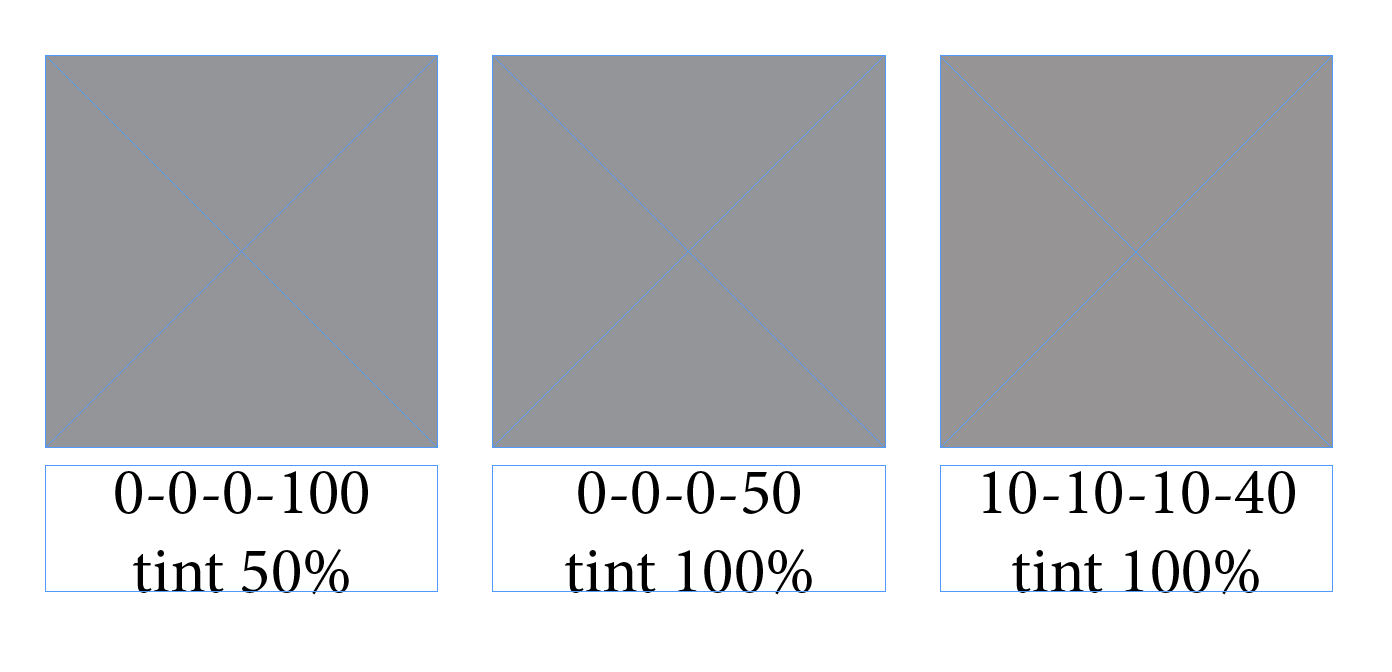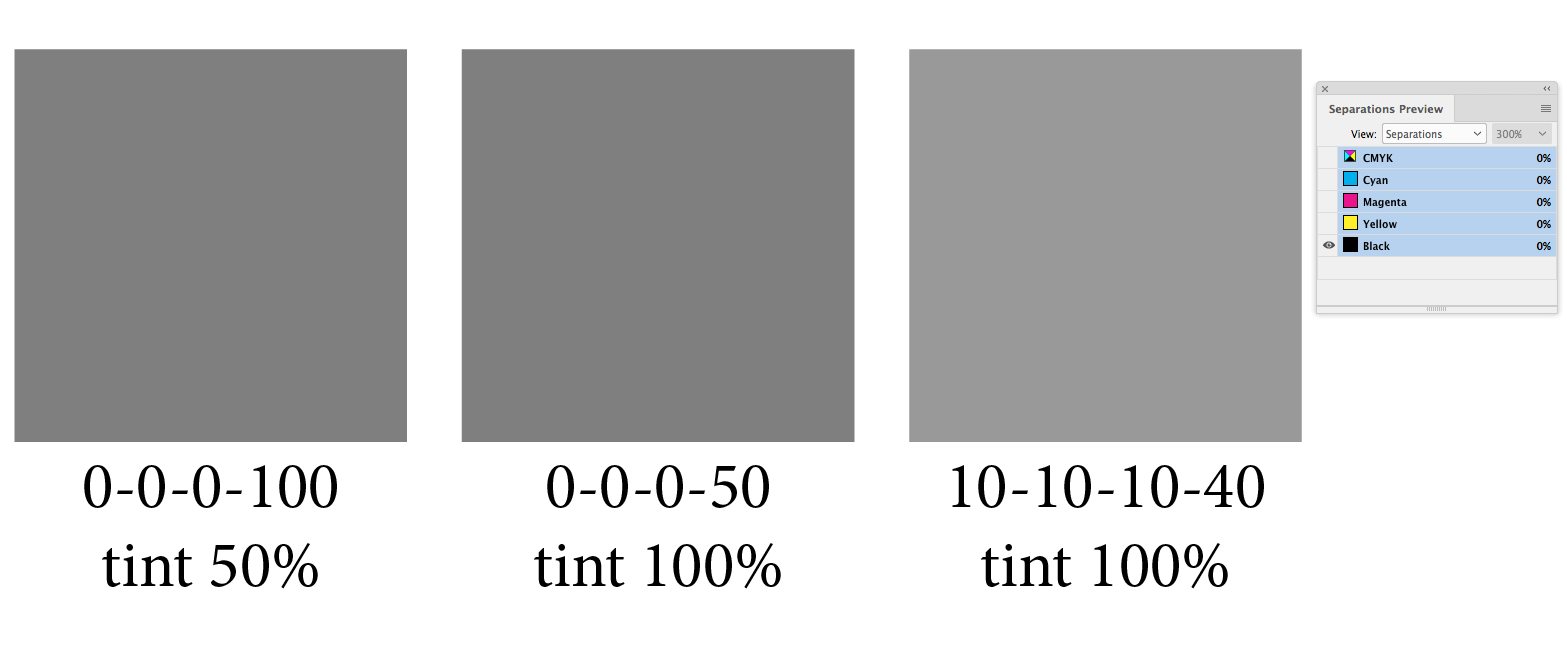- Home
- InDesign
- Discussions
- Re: is grayscale transparency or gradients?
- Re: is grayscale transparency or gradients?
Copy link to clipboard
Copied
hi I am doing a homework and my professor want us to make an ad with
- Print file, CMYK color mode (though you will be limited to black and white,
- Note you can use 10%, 20%, 30%, etc. up to 90% of black. this is called "grayscale.)
is grayscale transparency effect or gradient effect?
 1 Correct answer
1 Correct answer
debbiea22675948 wrote
Now I am more confused than before! So what does my teacher want me to do
then? I thought he was talking about transparency or gradient....
If you make a color or swatch in InDesign, the only Color Mode options will be CMYK, RGB, or Lab. It sounds like your instructor wants you to limit the color and swatch use to CMYK, with the CMY values set to 0.
Copy link to clipboard
Copied
None of the two. It's just a percentages of black:

Copy link to clipboard
Copied
Grayscale is a color mode (or color space) and not an effect.
- Print file, CMYK color mode (though you will be limited to black and white,
To avoid confusion, it's worth noting that InDesign documents can not be assigned a single color mode. A page can have a mix of objects that have fills and strokes defined with different color modes (CMYK, RGB, or Lab).
When you fill or stroke an object with a percentage of the default [Black] swatch, you are using a CMYK color. InDesign has no Grayscale color mode or color space. You can't make a swatch defined as 50% Gray—it has to be a 0|0|0|50 CMYK mix.
You can place a grayscale mode image, but it is normally output to the CMYK black channel unless there is a forced color conversion when you output or export.
Copy link to clipboard
Copied
Now I am more confused than before! So what does my teacher want me to do
then? I thought he was talking about transparency or gradient....
Copy link to clipboard
Copied
Transparency measures the opacity of an object, regardless of its colour or if it has a gradient.
A gradient is a blend from one colour to another (and possibly on to even more colours). Either or both or neither colour can be a greyscale value. Transparency can be applied to a gradient or not.
Greyscale Is just a percentage of process black used as a fill or stroke, as a colour in a gradient, or as the colour mode of a placed image.
Transparency can can be applied to a gradient. A gradient can be greyscale so long as all the colour values used in it are shades of process black.
IOW transparency, gradients, and greyscale are three different things.
Copy link to clipboard
Copied
debbiea22675948 wrote
Now I am more confused than before! So what does my teacher want me to do
then? I thought he was talking about transparency or gradient....
If you make a color or swatch in InDesign, the only Color Mode options will be CMYK, RGB, or Lab. It sounds like your instructor wants you to limit the color and swatch use to CMYK, with the CMY values set to 0.
Copy link to clipboard
Copied
debbiea22675948 wrote
Print file, CMYK color mode (though you will be limited to black and white
I think that just means to not use any colors other than black, and even though tints of black or levels of black that aren't 100% don't look like what we normally think of as black, they are made from just the black channel. Here are three similar colors. The third one uses colors other than black, but you may not notice just by looking at it.

…but if I turn off the CMY channels, it looks lighter than the other two…

There are times when you want to mix other colors into black to get what's called a rich black or 4-color black, but don't do that for this assignment.
Copy link to clipboard
Copied
You are adding to the confusion of OP. The professor means to use the CMYK colour mode with the C, M and Y components set to 0 and the K value anything between 10% and 90% (may be in 10% steps) in addition to 0% (white) and 100% (black).
Copy link to clipboard
Copied
Copy link to clipboard
Copied
Migintosh wrote
Abambo wrote
You are adding to the confusion of OP.
That's your opinion.
Correct and I stay with that opinion.
Migintosh wrote
Abambo wrote
The professor means to use the CMYK colour mode with the C, M and Y components set to 0…That's what I said.
Well, may be I’m of limited understanding, but your examples are confusing even me even that I understand what you are writing. But more important, the question was transparency or gradient and the answer is neither the one nor the other. Why don’t you show what is required instead of showing examples of CMYK mixtures and tints of those. You clearly should have sensed from the question that the OP is just starting and has limited knowledge of the subject. Don’t confuse with advanced topics like mixing inks...
Conclusion: What you answered is correct, but did not address the question. Your examples should have shown what has been asked for (by the professor). But that is « only » my opinion.



